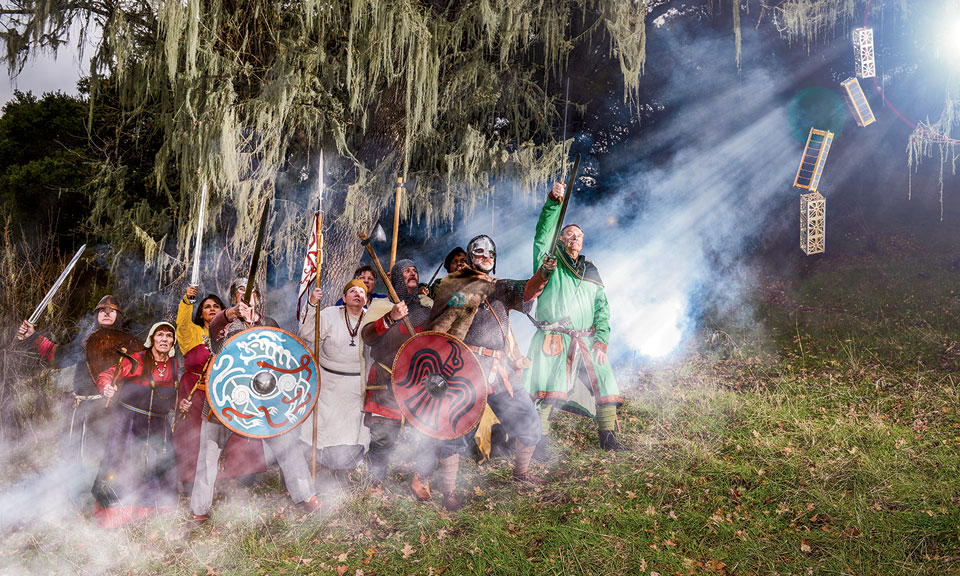
Nick Wass/AP
Teaming Up With Baseball
Forest Service lab develops new specs for bats to reduce the dangers of shattering.
By Charles S. Clark
Forest Service employees who love a trip to the ballpark enjoy some bragging rights not available to the average fan of big league baseball. For five years, one of the agency’s forest product labs in Madison, Wis., has worked in partnership with Major League Baseball to ease one of the sport’s ongoing safety risks: wooden bats that could shatter and injure players—and spectators.
Thanks to research coordinated by engineer David Kretschmann—a 26-year Forest Service veteran who has viewed video of every bat break in the majors for the past five years—a solution was identified that has already cut in half the incidence of broken bats.
The chief reason the Louisville Slugger was overly delicate, researchers found, was inconsistency of wood quality, primarily the manufacturing detail called “slope of grain.” They also noticed that low-density maple bats tended not only to crack but to break into pieces more often than ash bats or higher-density
maple bats. The solution, they decided, was thicker handles and less deviation in the grain going lengthwise.
Working with a third-party wood inspection service called TECO, the lab created manufacturing size specifications, limits on wood density and new wood drying techniques that were put to use by bat makers such as Kentucky-based Hillerich & Bradsby.
The number of broken bats has decreased steadily, from 5,268 (2.04 per game) in 2009 to 4,813 (1.83 per game) in the 2012 season. The number of multiple piece fractures dropped from 1,670 in 2009 to 1,209 in 2012, according to the Forest Service, and the low rate continues in 2013.
Guns and Butter
The number of Americans on food stamps keeps growing, and that increase includes members of the military. Food stamp recipients who identified themselves as service members spiked between fiscal 2010 and fiscal 2011.
Sequestration Bubbles Up
Some effects of sequestration are well known: children unable to attend Head Start, seniors not receiving subsidized meals and federal employees taking pay cuts as a result of furloughs.
Other consequences of the across-the-board cuts, however, have flown under the radar. And soon, asteroids may be doing the same.
One program hit by reduced spending caps is the Air Force Space Surveillance System, which uses radar to scan the skies for potential threats to Earth. The Air Force was slated to shut down the program on Oct. 1.
Others feeling the pinch include the U.S. Geological Survey, which has scaled back travel for scientists who install and maintain monitoring equipment at volcano sites. The National Institutes of Health made headlines after a university scientist said he euthanized rabbits he couldn’t afford to house for lab experiments because of cuts in research grants. And the Bureau of Land Management is scaling back its program to protect wild horses and burros on public lands.
Fingers crossed there are no asteroids hurtling toward Earth or volcanoes preparing to erupt. Eric Katz
NSA’s Loss Could Be DHS’ Gain
As trust in the nation’s top spy agency declines, Homeland Security is primed to step in.
Consumer companies that used to request computer breach backup from National Security Agency cyber whizzes might not be as trusting of an agency accused of spying on their customers.
But who will those companies call for help now? Maybe the Homeland Security Department—which is working to earn more cyber cred.
In August, Defense Department officials tapped an IBM executive to work with DHS on encouraging military contractors to come clean about network incursions that might compromise government data. Daniel Prieto III was recruited to increase participation in a program that exchanges cyber incident reports among willing firms and the government. Part of the effort involves the disclosure of highly classified “signatures,” or intelligence on malware, discovered by NSA, a Defense agency.
“That’s a good example of where DHS’ role probably will become more important” than NSA’s role in assisting industry, says Christopher Finan, a former White House and Pentagon official who, until July, was involved in a Defense cyber offense research program called Plan X.
“The idea is that they would be the ones interfacing with the company, and NSA would just be the provider of the signatures,” he says. “DHS probably gains if they do this properly and it seems to me that they can gain more trust in being that actual neutral arbiter and providing those NSA capabilities, without the companies having to interface with NSA.”
Aliya Sternstein
NASA’s Viking Spirit
NASA employees pose with Vikings of Bjornstad, an educational group, to illustrate “the Viking spirit of exploration and adventure” at the Ames Research Center in Mountain View, Calif. The photo is part of the Physics in Vogue exhibit by Ames scientist and photographer Ved Chirayath. No federal resources were used for the photo shoot, he says, adding that the project “aims to shed light on profound contemporary physics discoveries by combining fashion photography, laboratory grade optical effects and scientific accuracy to create visual representations of complex science.”
NEXT STORY: America’s Other 1 Percent







